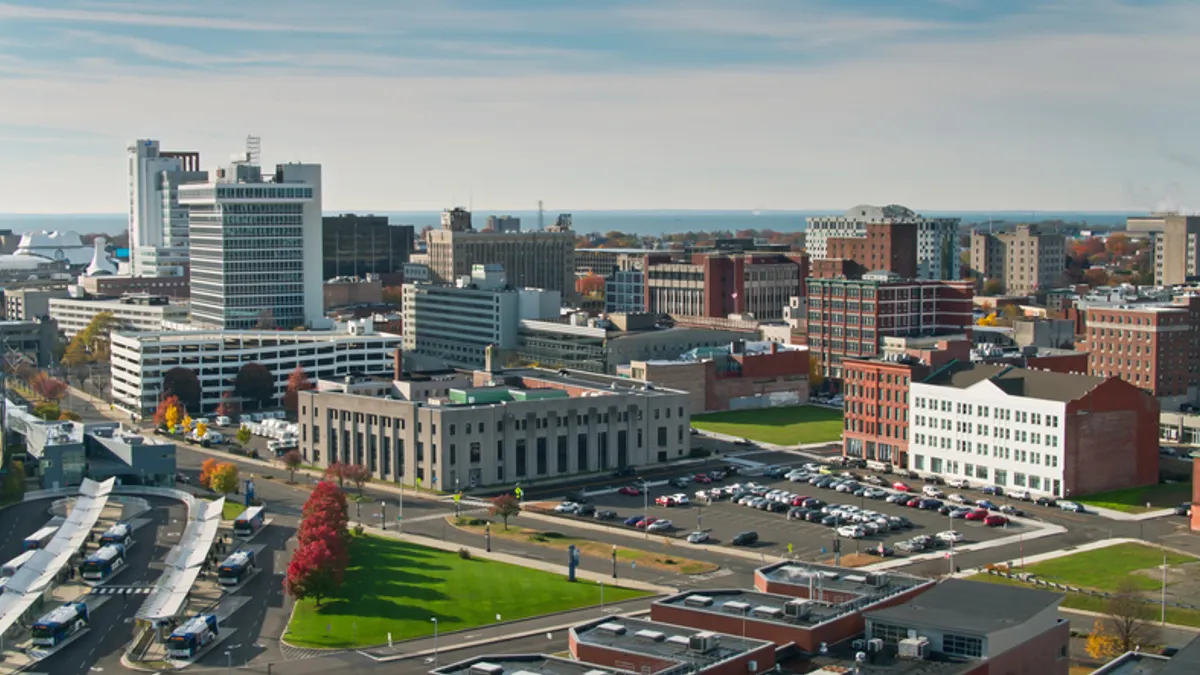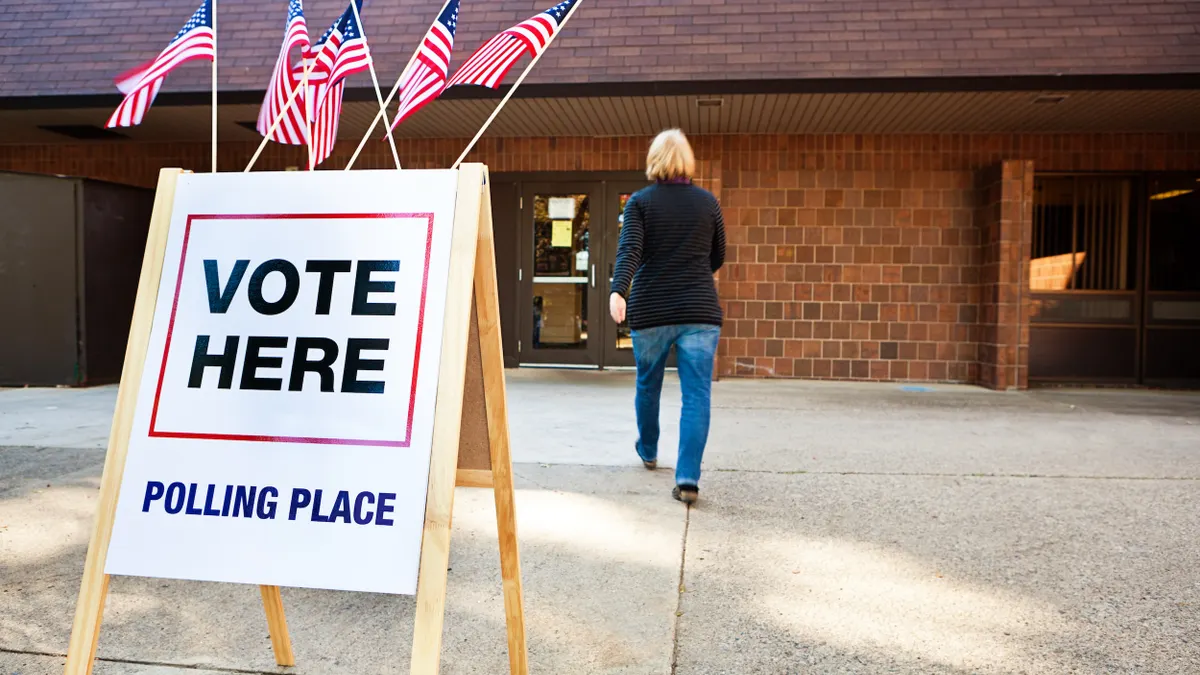American cities of all sizes have been rapidly transforming since the onset of the digital age. Innovation and technology are leading change and have prompted the use of the term "smart city" for many digital or data-driven advances. But what exactly is a smart city, and what is the path for earning that term?
During its "Transformers: Cities" event earlier this week, The Washington Post gathered thought leaders who are shaping the futures of U.S. cities. Speakers included city officials, strategists and technologists who spoke about what urban areas are doing to modernize and best serve the public, and what the future might hold. Smart Cities Dive analyzed key takeaways from the event.
1. Knowing how to analyze data is crucial
Overall, the smart cities movement is in its infancy, and municipal leaders are still trying to figure out how best to integrate technology and data into their operations.
"I think about government using data as a way to bring people together, to bridge divides that have been historically exacerbated by policy — and actually by the way that data has been collected and used to support decision-making," said Beth Blauer, founder of GovEx at Johns Hopkins University.
"For me, a smart city is... where the rubber meets the road," said Kate Garman, Seattle's smart city coordinator. "It’s how we use data to change how the city operates."
But a barrier for cities across the country is knowing exactly how to use data to make service and infrastructure improvements. "City governments have invested generations of resources into technology that is collecting data all the time, and they have absolutely no idea how to access that," Blauer said.
Best case scenarios for changing how a city operates — both inside and outside of the local government — include first identifying areas for improvement and then using data to solve problems. Successful and cost-effective implementation centers on using gathered data to strategically deploy resources that will benefit citizens.
2. Data inclusivity is key
Striving for digital inclusivity among all residents is a major focus. "To me a smart city is one that begins work centered on the resident and ends work centered on the resident," said Erie Meyer, Code for America National Network director. She echoes others' observations that data and technology can leave behind huge sectors of the population who aren't particularly tech-savvy or enabled, especially seniors and low-income residents. "You're ... fighting for the experience of the people in your city and ideally, the most vulnerable residents first."
"The onus is on ... the public sector to listen to people who are desperately asking for help."

Erie Meyer
Director, National Network, Code for America
For example, low-income residents often can't afford data plans for their cell phones, but providing them with free Wi-Fi — such as by installing Wi-Fi technology on streetlights — can improve their access to resources. That, in turn, can improve residents' mobility, ability to do school work or ability to complete tasks on the job. However, not considering these factors or creating a strategy in advance could mean that such technology first is installed in wealthy neighborhoods instead of neighborhoods with the greatest need.
Cities consistently face cultural issues while implementing resources, such as resistance from people who might not understand cloud computing or trust data collection. Conducting a testing phase on real people early in the process can help leaders ensure usability and reduce risk. "The tactic is to start with the users, to get in the neighborhoods, to sit down, to bring those colleagues along and don’t make it a scary tech thing," Meyer said. "The onus is on ... the public sector to listen to people who are desperately asking for help."
3. P3s can fill funding gaps
Securing adequate funding for municipal projects is a perennial issue, but it's even more apparent when taking on expensive technology projects. It can be a major holdback to becoming a smart city.
Less overall investment has been made in local governments since the Great Recession, Blauer said, both in terms of funding and training. "Any kind of support that we were giving the public sector completely disappeared ... and we under-invested in the capacity of the public sector ... as the private sector invested in their workforce," she said. That's left many municipalities under-prepared to be a network of data-forward, analytical thinkers.
More city leaders are realizing the benefits of filling information and funding gaps by investing in public-private partnerships. "Partnerships are key," Garman said. "A huge problem in cities is bandwidth for city staff."
4. P3s can also elevate city transit
Cities have spent decades investing in their public transportation infrastructures in various ways, but U.S. transit ridership is sagging across several categories, most notably bus ridership. Some blame the rise of ride-share services, but much of it comes down to the theme of not evolving with an increasingly convenience-driven society.
The past few years have brought innovations in public transportation, with a focus on convenience and first mile/last mile services. More public transit agencies also are forging alliances with other transportation providers, such as the partnership between Phoenix and Lyft. "Transportation ... has to be a public-private partnership," said Raj Kapoor, chief strategy officer for Lyft. "From a consumer's perspective, the lines start to blur."
Many cities' transit authorities operate separately from the local government, and they also should foster strong partnerships, said Jeffrey Tumlin, principal and director of strategy at Nelson\Nygaard Consulting Associates. "If cities and transit agencies operate together not only can they improve transit, but they can be much better partners for companies ... as they're creating new technologies to do the things that transit is not good at," he said.
Changing transportation structures have many asking what the role is for a public transit agency, said Jessica Robinson, director of city solutions at Ford Smart Mobility. "People are very excited about the opportunity to have different kinds of vehicles, different pricing structures, working with a variety of solutions to actually deliver on the core promise of public transit, which is to help people move around," she said. It's a matter of finding "the right option for the right trip."
An option currently receiving a lot of attention from cities like Los Angeles is the growth of microtransit, which involves riders sharing on-demand trips in vehicles that are bigger than a car but smaller than a bus, such as vans. "[Microtransit] fills in a gap between the benefits of cars owned ... and public transit," Robinson said. "It's a flexible vehicle ... but it's shared."
Despite all the changes, "Transit is not going away," Kapoor said. "What it's going to be is a combination, even in the world of autonomous vehicles at full tilt."
5. AVs will bring 'profound' changes
Although cities are starting to test autonomous vehicles in both simulations and a few real-life situations, transportation experts don't anticipate a tsunami of AVs on the roads anytime soon. "This is going to be a very gradual change," Kapoor said. "Most autonomous vehicles are slowly learning the world around them. Think about the number of potential scenarios that a car has to encounter."
After AVs become more prevalent, citizens will have to get comfortable interacting with them. "There's a lot of questions that consumers have and they have a lot of questions around trust," said Kapoor. "We think for the next decade or more it's going to be a combination of AV drivers and human drivers, even in ride-sharing, and that will get people comfortable."
"In the short run, I'm not sure we're going to see a lot of change," Tumlin said. "In the long run, though, the changes are going to be profound." He said some of the likely changes will include advertising inside of autonomous vehicles once passengers no longer have to pay attention to the road and advertisers have a captive audience.
"It really goes to the deeper question of, what do we want autonomous vehicles to do for us in our cities?" Robinson said. "I think there's a real potential to improve access."
Transitioning to a society with daily human-AV interactions will take patience and teamwork. "We're all learning how to work through these things together in real time," Robinson said.




















